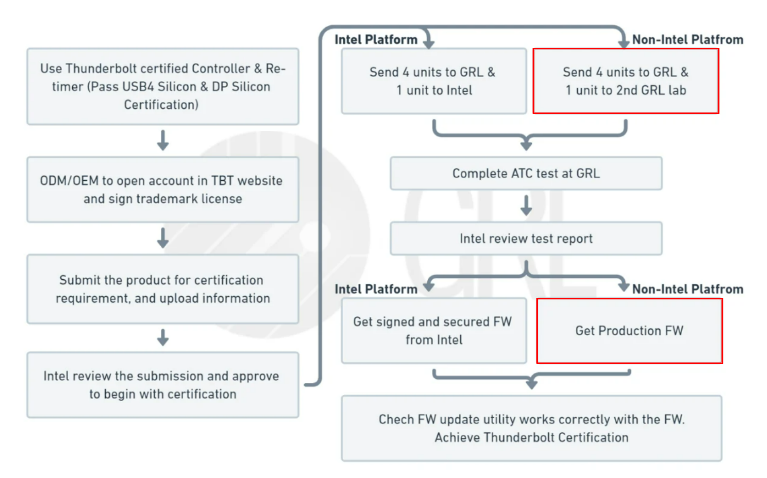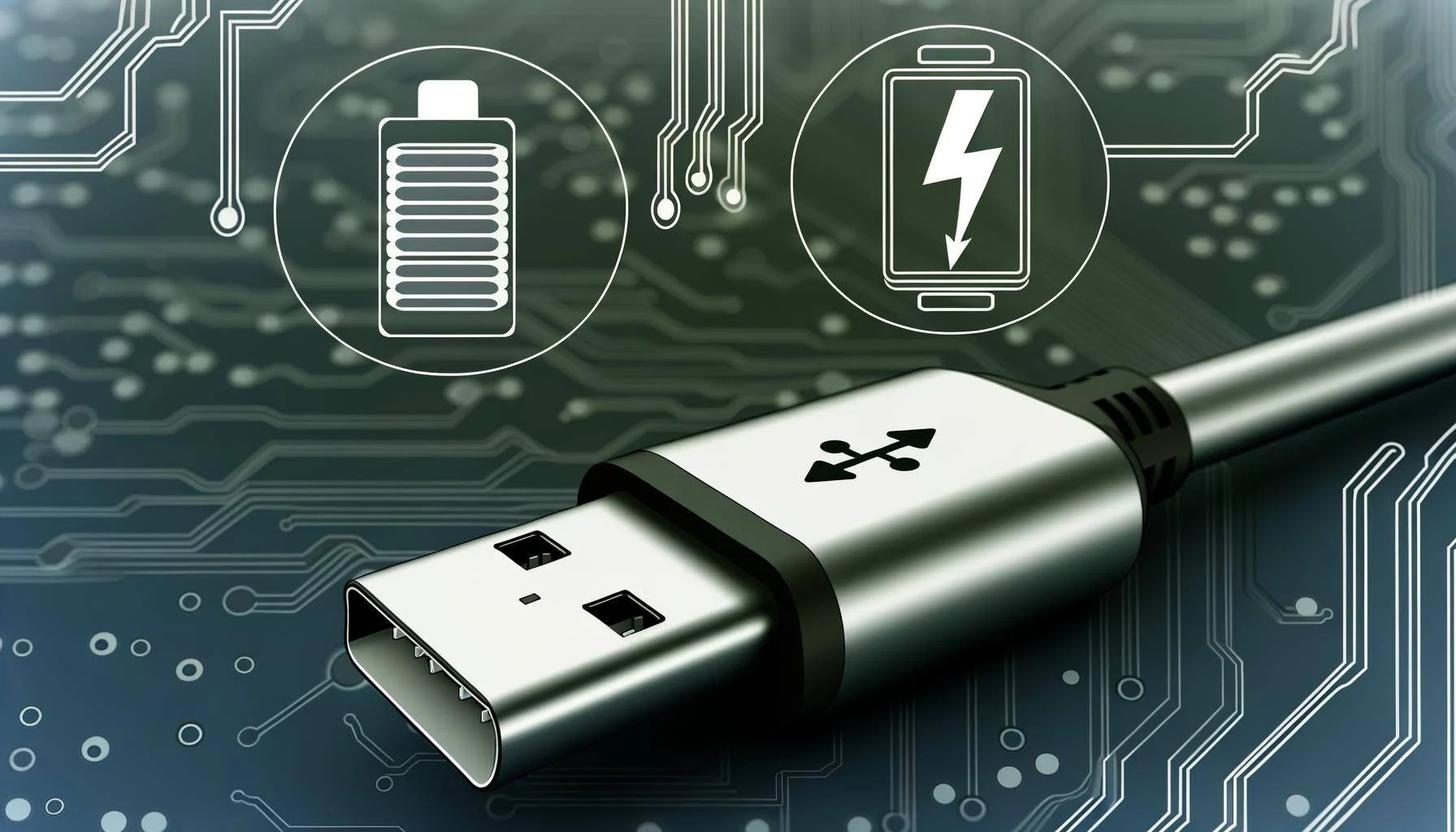Granite River Labs, GRL
楊宗霖 Robert Yang
In today's consumer electronics market where demand for high-speed interface technology has gone into overdrive, Thunderbolt™ and USB4® have emerged as the dominant technologies. Against this backdrop, GRL has successfully assisted a renowned laptop manufacturer in obtaining Thunderbolt™ certification for their devices that are equipped with AMD CPUs. This marks the first time a non-Intel platform has become Thunderbolt™ certified, highlighting a significant milestone in the field of compliance testing.
Both Intel and AMD are major semiconductor suppliers supporting USB4® technology across various platforms. Additionally, several other integrated circuit (IC) manufacturers are gearing up and preparing to enter the market for USB4® and Thunderbolt™ 4. Regardless of the CPU, controller, re-timer, or PD solution used, GRL’s seasoned engineers are well-equipped to address product development challenges and assist customers in obtaining certification.
USB4® vs Thunderbolt™ 4
USB4® and Thunderbolt™ 4 both offer a maximum bandwidth of up to 40Gbps and support tunneling functionality for simultaneous audio, video, and data transmission. However, they differ in their minimum support requirements. For instance, USB4® has a minimum support requirement of 20Gbps, while Thunderbolt™ 4 necessitates support for 40Gbps and additional features such as dual display.
In short, USB4® provides standard functionality, while Thunderbolt™ 4 offers a comprehensive range of features, making it the preferred choice for those who require higher bandwidth and a broader range of features.
Challenges in testing and certifying new USB4® platforms for Thunderbolt™
Even if the same testing documents (CTS) are followed, new USB4® platforms (Non-Intel) may still encounter various testing challenges during the Thunderbolt™ certification process. With a brand-new IC solution, there will be many unprecedented issues for R&D and verification teams to overcome, which experts predict will result in at least double the test time.
Electrical validation (EV)
During EV testing on the new USB4® platform (non-Intel), it is necessary to configure specific parameter settings on the USB4® ETT Tool. For example, there are different approaches to test Control PC and connection methods. By engaging in continuous discussions and revisions with manufacturers, our experienced test engineers at GRL have conducted successful experiments to address various testing challenges and key focus areas in passing EV testing.
Functional validation (FV)
The Thunderbolt™ FV CTS requires parameters like Link Speed, Link Width, Link Type, and HEC Error during each plug-and-play event to be monitored. As the existing Intel USB4® Monitor is incompatible with new non-Intel platforms, manufacturers involved in USB4® development must design dedicated tools for their respective platforms to validate these parameters. Through close collaboration with various USB4® chip suppliers, GRL offers recommendations based on CTS and testing principles and finally assisted our customer in producing the stable and reliable USB4® CM Monitor. This tool helps users and testers accurately determine whether the connected USB4® / Thunderbolt™ 4 devices meet the expected connection quality.
The FV CTS outlines four stress tests, including 500 iterations of Cold Boot, Warm Boot, Unplug-Plug, and Sleep Cycle. Each test typically takes approximately 10-20 hours to complete, and conducting manual tests for all of them would be highly time-consuming. To address this issue, GRL engaged in discussions with new USB4® chip suppliers, emphasizing the need to develop automated tools at the earliest to streamline testing processes for numerous projects. With active collaboration, experimentation, and continuous feedback from new USB4® semiconductor suppliers, our customer’s USB4® automated testing software is now able to shorten testing timelines and significantly reduce the occurrence of human errors.
Thunderbolt™ certification process
The following diagram illustrates the Thunderbolt™ certification process. For non-Intel platforms, special attention should be given to differences in steps highlighted in the red boxes.

Figure 1: Thunderbolt™ certification process flowchart
Requiring validation from two different laboratories, the Thunderbolt™ certification standards are known to be highly stringent. Usually, third-party testing laboratories like GRL will conduct comprehensive EV and FV testing, while Intel laboratories will perform Cross Correlation testing. However, after taking into account that the design of non-Intel platforms often involve competitive considerations, Intel allows manufacturers to choose two different authorized labs to conduct product testing. For example, after completing thorough testing at GRL Taipei, manufacturers can choose to send their prototypes to another GRL lab in a different location, such as GRL Shanghai or GRL Dongguan, for Cross Correlation testing. GRL's labs in Taipei, Dongguan, and Shanghai are all authorized Thunderbolt™ testing facilities, which is why customers can opt for any two of these locations for testing.
For new USB4® platforms (non-Intel), it is still necessary for manufacturers to provide production firmware to the certification laboratories and conduct FW Update testing. This is done to enable consumers to update the firmware themselves using the FW Update Tool after the product is launched, ensuring that the USB4® / Thunderbolt™ 4 functionality stays up-to-date and promptly addresses compatibility issues in the market.
Navigating Thunderbolt™ certification for non-Intel platforms
Despite Intel's decision to open up Thunderbolt™ certification to non-Intel platforms, it is important for manufacturers to keep in mind that the Thunderbolt™ CTS was originally designed for Intel platforms. During the certification process for non-Intel platforms, engineers may discover minor details of non-Intel platforms that do not align with the CTS despite having met the manufacturer’s expectations. In such cases, effective communication and collaboration between GRL, with our extensive experience and knowledge in USB4® certification processes, and Intel's certification units are crucial in resolving common issues encountered during the certification process.
How fast is Thunderbolt™ 4?
The next generation of Thunderbolt™ and USB4® Version 2 are already on the horizon, boasting impressive transmission speeds of up to 80Gbps and 120Gbps respectively. In anticipation of a new era of high-speed data transfer, GRL has proactively prepared a comprehensive testing environment. Equipped with PAM3 technology, we are able to assist customers in validating signal quality and ensuring the development of efficient and stable products.
Test your Thunderbolt™ products at GRL
As the first certification lab in the world qualified by Intel, we offer full testing services for Thunderbolt™, including EV and FV testing. With years of experience in the certification and testing field, GRL excels particularly in high-speed interface testing, backed by extensive testing experience, domain knowledge, and strong industry relationships. These advantageous resources allow GRL to provide comprehensive support to customers, significantly reducing the pains and burdens of the development process.
Author
Robert Yang – Test Engineer, GRL (Taipei)
Robert has six years of testing experience and is familiar with the testing specifications for DisplayPort™, Thunderbolt, and HDMI®, USB. He is currently responsible for compatibility testing at GRL (Taipei) and helps customers solve problems and successfully obtain certification.



